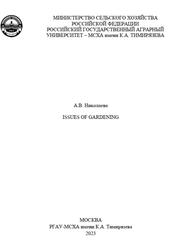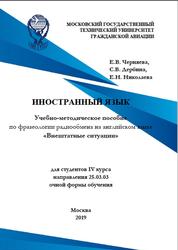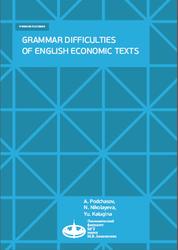Обучение разговорной речи и чтению литературы на английском языке по специальности сварка, Гурова Г.Г., Николаева Н.С., 2010.
В учебно-методическое пособие включены тексты из оригинальной научно-технической английской и американской литературы по специальности «Оборудование и технология сварочного производства», предназначенные для аудиторной и самостоятельной работы студентов. В каждый урок входят также задания по развитию навыков перевода с английского языка на русский, ведения беседы по основным проблемам, затронутым в пособии, переводу с русского языка на английский и отработке лексических и грамматических трудностей, встречающихся в текстах.
Для студентов старших курсов.
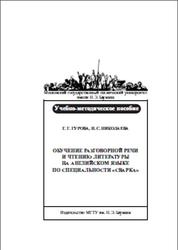
Parts of Joints.
While there are many variations of joints, the parts of the joint are described by standard terms. The root of a joint is that portion of the joint where the metals are closest to each other. The root may be a point, a line, or an area, when viewed in a cross section. A groove is an opening or space provided between the edges of the metal parts to be welded. The groove face is that surface of a metal part included in the groove. A given joint may have a root face or a root edge. The root face is the portion of the prepared edge of a part to be joined by a groove weld that has not been grooved. As you can see, the root face has relatively small dimensions. The root edge is basically a root face of zero width. The groove face and the root face are the same metal surfaces in some joints. The specified requirements for a particular joint are expressed in such terms as bevel angle, groove angle, groove radius, and root opening. The bevel angle is the angle formed between the prepared edge of a member and a plane perpendicular to the surface of the member. The groove angle is the total angle of the groove between the parts to be joined. For example, if the edge of each of two plates were bevelled to an angle of 30 degrees, the groove angle would be 60 degrees. This is often referred to as the “included angle" between the parts to be joined by a groove weld.
The groove radius is the radius used to form the shape of a J- or U-groove weld joint. It is used only for special groove joint designs. The root opening refers to the separation between the parts to be joined at the root of the joint. It is sometimes called the “root gap." To determine the bevel angle, groove angle, and root opening for a joint, you must consider the thickness of the weld material, the type of joint to be made, and the welding process to be used. As a general rule, gas welding requires a larger groove angle than manual metal-arc welding. The root opening is usually governed by the diameter of the filler material. This, in turn, depends on the thickness of the base metal and the welding position.
Contents
Предисловие
Unit 1. Weld Joints. Parts of a Joint
Unit 2. Butt Joint Welds
Unit 3. Corner, Edge, Tee, and Lap Joints
Vocabulary
Keys to the Exercises
Литература.
Бесплатно скачать электронную книгу в удобном формате, смотреть и читать:
Скачать книгу Обучение разговорной речи и чтению литературы на английском языке по специальности сварка, Гурова Г.Г., Николаева Н.С., 2010 - fileskachat.com, быстрое и бесплатное скачивание.
Скачать pdf
Ниже можно купить эту книгу, если она есть в продаже, и похожие книги по лучшей цене со скидкой с доставкой по всей России.Купить книги
Скачать - pdf - Яндекс.Диск.
Дата публикации:
Теги: учебник по английскому языку :: английский язык :: Гурова :: Николаева
Смотрите также учебники, книги и учебные материалы:
Следующие учебники и книги:
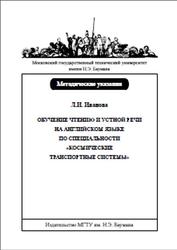 Обучение чтению и устной речи на английском языке по специальности космические транспортные системы, Иванова Л.И., 2012 — В методических указаниях содержатся учебные материалы: тексты на английском языке, словарные терминологические блоки, предтекстовые и послетекстовые лексико-грамматические упражнения, способствующие пониманию … Книги по английскому языку
Обучение чтению и устной речи на английском языке по специальности космические транспортные системы, Иванова Л.И., 2012 — В методических указаниях содержатся учебные материалы: тексты на английском языке, словарные терминологические блоки, предтекстовые и послетекстовые лексико-грамматические упражнения, способствующие пониманию … Книги по английскому языку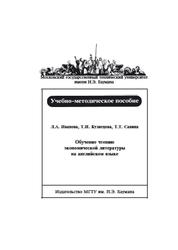 Обучение чтению экономической литературы на английском языке, часть 3, Иванова Л.А., Кузнецова Т.И., Савина Т.Т., 2009 — Пособие состоит из трех разделов - уроков. Каждый урок содержит основной текст, дополнительные тексты для поискового чтения, упражнения на активизацию … Книги по английскому языку
Обучение чтению экономической литературы на английском языке, часть 3, Иванова Л.А., Кузнецова Т.И., Савина Т.Т., 2009 — Пособие состоит из трех разделов - уроков. Каждый урок содержит основной текст, дополнительные тексты для поискового чтения, упражнения на активизацию … Книги по английскому языку Обучение чтению экономической литературы на английском языке, часть 2, Иванова Л.А., Кузнецова Т.И., Лазарева З.Р., Можайко Л.И., 2009 — Учебно-методическое пособие предназначено для обучения переводу и пониманию экономической литературы на английском языке. Пособие состоит из трех уроков. Каждый урок … Книги по английскому языку
Обучение чтению экономической литературы на английском языке, часть 2, Иванова Л.А., Кузнецова Т.И., Лазарева З.Р., Можайко Л.И., 2009 — Учебно-методическое пособие предназначено для обучения переводу и пониманию экономической литературы на английском языке. Пособие состоит из трех уроков. Каждый урок … Книги по английскому языку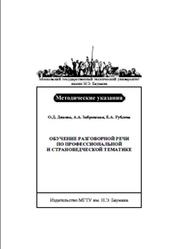 Обучение разговорной речи по профессиональной и страноведческой тематике, методические указания, Дикова О.Д., Забровская А.А., Рублева Е.А., 2011 — Методические указания состоят из пяти уроков. Каждый урок объединен одной тематикой и содержит: терминологический словарь, несколько текстов, первый из которых … Книги по английскому языку
Обучение разговорной речи по профессиональной и страноведческой тематике, методические указания, Дикова О.Д., Забровская А.А., Рублева Е.А., 2011 — Методические указания состоят из пяти уроков. Каждый урок объединен одной тематикой и содержит: терминологический словарь, несколько текстов, первый из которых … Книги по английскому языку
Предыдущие статьи:
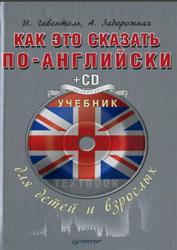 Как это сказать по-английски, Гивенталь И., Задорожная А., 2012 — Книга представляет собой учебно-методическое пособие для взрослых, которые хотят помочь своим детям и себе ЗАГОВОРИТЬ, НАКОНЕЦ, ПО-АНГЛИЙСКИ! Курс разработан в … Книги по английскому языку
Как это сказать по-английски, Гивенталь И., Задорожная А., 2012 — Книга представляет собой учебно-методическое пособие для взрослых, которые хотят помочь своим детям и себе ЗАГОВОРИТЬ, НАКОНЕЦ, ПО-АНГЛИЙСКИ! Курс разработан в … Книги по английскому языку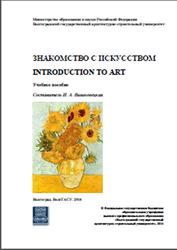 Знакомство с искусством, Вишневецкая Н.А., 2014 — В сборнике представлены аутентичные тексты по специальности Монументально-декоративное искусство . Содержится лексический материал для запоминания и терминологический словарь. Для студентов … Книги по английскому языку
Знакомство с искусством, Вишневецкая Н.А., 2014 — В сборнике представлены аутентичные тексты по специальности Монументально-декоративное искусство . Содержится лексический материал для запоминания и терминологический словарь. Для студентов … Книги по английскому языку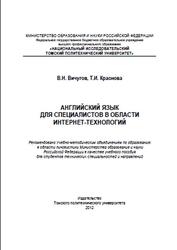 Английский язык для специалистов в области интернет-технологий, Вичугов В.Н., Краснова Т.И., 2012 — Пособие направлено на формирование и развитие у студентов языковых и речевых навыков и умений использования английского языка в сфере профессиональной … Книги по английскому языку
Английский язык для специалистов в области интернет-технологий, Вичугов В.Н., Краснова Т.И., 2012 — Пособие направлено на формирование и развитие у студентов языковых и речевых навыков и умений использования английского языка в сфере профессиональной … Книги по английскому языку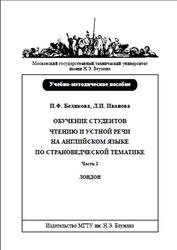 Обучение студентов чтению и устной речи на английском языке по страноведческой тематике, Лондон, часть 1, Беликова И.Ф., Иванова Л.И., 2011 — Пособие посвящено изучению страноведческих экзаменационных материалов по стране изучаемого языка Великобритании. Представлены оригинальные тексты, разработаны лексико-грамматические упражнения, задания по практике … Книги по английскому языку
Обучение студентов чтению и устной речи на английском языке по страноведческой тематике, Лондон, часть 1, Беликова И.Ф., Иванова Л.И., 2011 — Пособие посвящено изучению страноведческих экзаменационных материалов по стране изучаемого языка Великобритании. Представлены оригинальные тексты, разработаны лексико-грамматические упражнения, задания по практике … Книги по английскому языку

